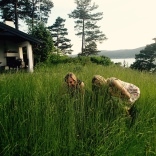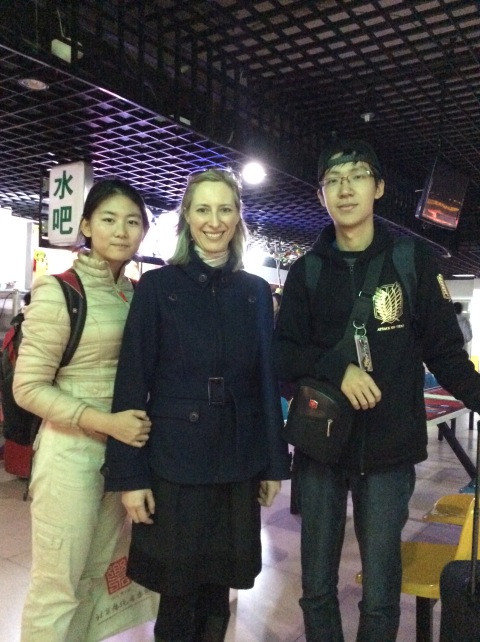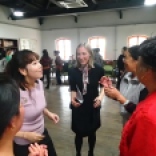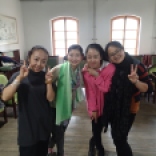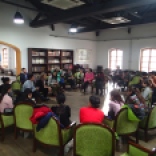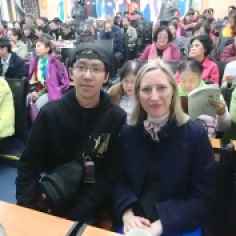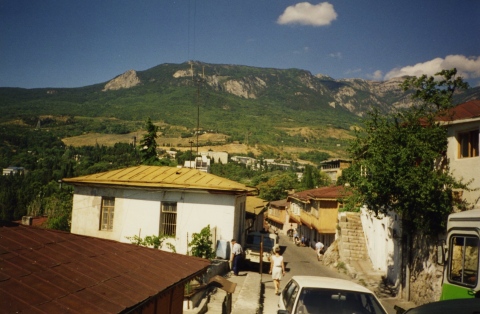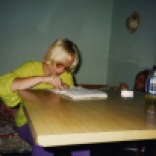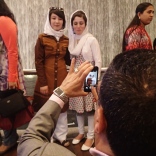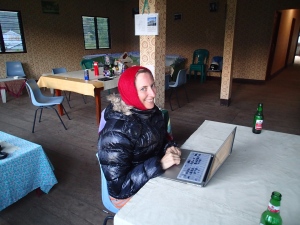Archive for the ‘travel’ Category
Summer weekend on the Oslo fjord
This weekend was the end of my first week in Oslo and a friend from work invited me to join her for a weekend trip to Hvitsten (White Stone), a small village halfway along the Oslo Fjord. We set off on Friday evening after work, and given how gloriously warm the weather has been this week (+/- 28 degrees Celcius each day), we were not the only people making a break for the coastline.

Wenche’s summer house is a small wooden cabin, nestled among trees overlooking the water. She told us how they’d recently updated the interior, painting it all white (floors, walls, ceilings) and drastically reducing the amount of furniture. The result is an incredibly peaceful, light-filled space, and with the sun barely setting at this time of year in Norway, it was like being inside a cloud!
It was her first visit in a while, and Wenche was horrified at the length of the grass, especially as she knew her lawn mower was a temperamental machine that (literally and figuratively) wouldn’t cut it. But Anne and I were charmed.
Like Australians, Norwegians love the outdoors and do much of their summer living outdoors. Wenche’s home as an outdoor patio/eating/sitting area, like a half-cabin, with its own fireplace and chimney, long dining table and couch. We ate dinner there both nights. From here the sunset views (starting from around 10.30pm) were magnificent and lasted for hours. I have no idea what time the show finally ended, as I’d gone to bed. But we are nearly at the solstice here (the ‘turning of the sun’, as the locals call it in English) and there are very few hours of darkness each night. In fact, I don’t think it ever gets truly dark.
We swam! This was a highlight of the trip. We put on bathrobes made of light-weight fleece (apparently they are Turkish, and used in hamaams there) and walked a little way from the cabin to the local beach. Wenche recommended that the best way into the water was via the ladder, rather than from the shoreline. With the nip in the air coming off the water, I wondered if I really wanted to do this. “Oh. You’re not a real Norwegian,” said Wenche dismissively. That decided it, I was in.

My God, it was icy. ‘Swimming’ is a misnomer; it was definitely more of a dip. No heads went under. I went in twice on Saturday; the second time I managed 24 breaststrokes altogether before getting out. That was pretty good. A neighbour brought out a thermometer to check the water temperature – it was 14 degrees. And we went in twice – morning and afternoon! We cheered ourselves afterwards.
On Saturday I was excited to go to a local flea market. Packing for a 6 month trip where most of it is in tropical Sri Lanka, but 2 months are in much cooler Norway and Scotland, I knew I could use a couple of warmer bits of clothing. The Vestby Flea market (raising money for the local youth marching band) was right place to find these – I bought a warm Swedish-made merino jumper, and a pair of boots. I also found an atlas (my mental map of Scandinavia and northern Europe beyond the Baltic states and Poland had proved wanting in the previous night’s conversation) and an English-Norwegian dictionary. Anne found a very demure 1950s handbag. Good haul.

Anne’s new handbag
We also visited Hvitsten village, which is an incredibly pretty little place, with views up the fjord out to the open sea, many beautiful wooden houses, a fairy-tale wooden church, and with its many manicured gardens and public spaces punctuated with figureheads from old ships. The story is, Hvitsten is home to a family that made its fortune in shipping. All the figureheads have been re-purposed as civic monuments after the ships they decorated were decommissioned. Many of the village’s public spaces, along with the church, were also gifts from this billionaire family to the people.
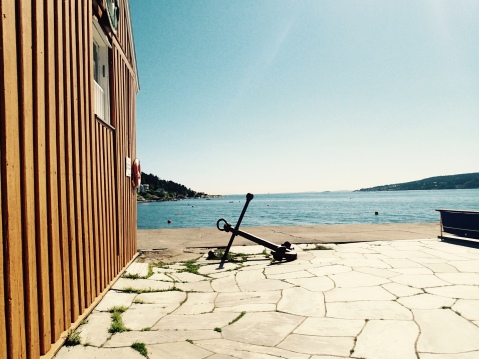



The landscape is filled with wildflowers. Anne told me that purple and yellow are considered “the colours of June”. As well the flowers that we picked near Wenche’s cabin, the roadsides were filled with giant pink and purple lupins.
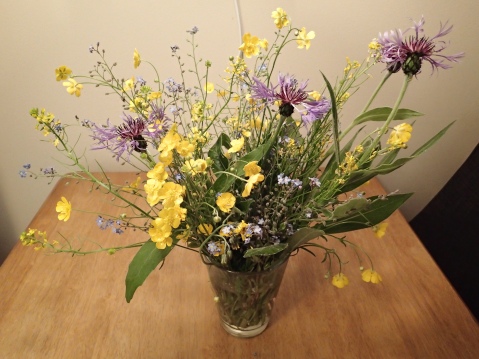
All very pretty, all very idyllic. Nice to see some of the Norwegian countryside (which is so central to Norwegian identity) so early in my stay here. I brought some of it back to my small apartment in central Oslo, the flowers posing here with my flea market haul.

New project – music and reconciliation in Sri Lanka
At the end of last year I was awarded one of the Australian Government’s Endeavour Research Fellowships to develop a research project examining music development activities as a vehicle for reconciliation in Sri Lanka. Fast forward a couple of months and here I am in Colombo, sitting in a small apartment in a seaside suburb, getting my research project off the ground.
I’ve been here a little more than a week now. In that time, I’ve stayed in a guest house in the seaside suburb of Mount Lavinia, flat-hunted in two different suburbs eventually moving into a flat in Dehiwala, jogged on the beach at sunrise several times, eaten different varieties of rice and curry on a daily basis, attended a Carnatic Music Festival and a performance by the Symphony Orchestra of Sri Lanka, and joined the masses at the February Full Moon Perahera (Procession) Gangaramaya Temple in central Colombo. I’ve also had long conversations with colleagues here, mapped my way through the different activities that make up the Sri Lanka Norway Music Cooperation [SLNMC], and begun to scope out what the research project should include.
The Sri Lanka Norway Music Cooperation is, of course, the reason I’m here. It’s a partnership between Concerts Norway and Sevalanka Foundation in Sri Lanka that aims to revive and support traditional music practices, build practical and logistical skills among music industry professionals to raise standards of live performance (for example, supporting the skills development of audio and lighting personnel, music event management professionals, and field recording producers), and engage different sectors of society in music participation. The flagship events of the Music Cooperation are the Jaffna (in the north) and Galle (in the south) Music Festivals, held in either city in alternate years. The festivals attract tens of thousands of visitors, and gather together traditional and contemporary music performers from across the country. Other Music Cooperation activities include workshop programs in universities, a Children’s Festival, training for the next generation of folk musicians (i.e. children) to encourage them to feel proud and excited by the traditional instruments, music and dances of their local area and ethno-religious heritage, a radio program, development of a comprehensive online music archive, and partnerships with three national orchestras (symphony, youth, and oriental) based in Colombo.
So where do peace and reconciliation come into this program of music development? Anecdotally, in all sorts of ways – through the opportunities it provides for performers from around the country to be exposed to each other’s traditional practices and instruments, to present their music to diverse audiences, meet in safe, welcoming, and depoliticized spaces, and importantly, the chance to talk and potential form friendships and collaborations. For audiences, it is in the cultural learning, and the demystifying of the ‘other’ (for during the three decades of civil war, the northern and eastern parts of the country became increasingly cut off and isolated from the capital city, central, western, and southern provinces). The different activities have not necessarily been designed to explicitly address peace and reconciliation needs — they are music activities first and foremost, and they have broad appeal for this reason. But participants and organizers alike feel they have witnessed and experienced positive changes in intergroup relations during the 7 years (so far) that the Music Cooperation has run, and there is a pressing need to examine more critically what impacts the program may be having on reconciliation between country’s divided communities.
And that’s where I come in. My role is to document the changes taking place in peace and reconciliation outcomes, as experienced by participants and organisers across the range of SLNMC activities. I’ll be developing research tools to best capture these changes and also allow for unexpected changes and outcomes so that we get a multidimensional picture of the different ways these music activities may impact people’s lives. I’ll then write a report that can inform future NSLMC activities and establish the baseline for future program evaluations. I’ll be doing this alongside my PhD work which examines music schools in post-conflict countries. There are lots of contextual similarities but also anomalies, and I’m curious to see if and how the emergent themes from my PhD research might play out here.
That’s the broad brushstroke picture of what’s planned; we are now working to narrow down and tighten up the scope. I am only in Sri Lanka for three months (I’ll be doing the write-up in Norway when I am there end-May to mid-July). One very interesting development that I learned of this week is that the presentation I gave for Bangladesh Music Week (at the invitation of Concerts Norway) in November last year on music, human rights, and conflict resolution has inspired a group of students from the University of Peredeniya (Kandy) to initiate a research project on their Music Cooperation activities using Allport’s contact hypothesis as a framework (this was one of the theoretical frameworks I introduced in my presentation). Hopefully I’ll be able to work with them to shape this project and include it as a component of my research.
This is my first blog post in many months, and that is largely because life took so many unexpected turns for me in the last 6 months. Sitting here in my airy (but still hot) little apartment, ceiling fan spinning reassuringly overhead, hearing neighbours call to each other in the street below, my stomach full from the egg hopper with caramelised onion sambal I ate for my dinner, thinking about the project ahead, and the PhD, and the whirlwind of events that have made up my life over the last 6 months, I find I keep thinking, “Wow. What a life!” And what a privilege, to get to engage with things you really care about (music, and social justice) in such diverse and fascinating places. Here goes! More soon.
Return to China
I loved this return visit to Beijing. It’s always nice to be hosted, and the Chinese are wonderful hosts! My plane touched down at 3am, and when I finally emerged through the gates into the public area (that airport is enormous, it took me ages to walk through given I was still recovering from my recent surgeries), two very tired but smiling student volunteers from the China Conservatory were there to meet me.
My first day was free of work tasks so one of the volunteers took me to the Panjiayuan antiques market where traders from different parts of China were selling antiques (some real, some less real) and handcrafts. I bought some gifts for family, friends and friends’ children, but mostly just loved the browsing and people-watching.
We also went to Beijing Glasses City. This is a mall filled with spectacle-sellers, lens-grinders, and optical accessories stalls. My student guide, Wang (although I later suggested an English name for him – Max – which he loved and immediately adopted) is from the Xinjiang Autonomous Region, up in the north-west, sharing the border with Kazakhstan and Kyrgystan, so Beijing Glasses City was a new discovery for him. I chose frames and got my eyes tested and had new glasses made within 30 minutes.
The next day I led a music workshop for community music and dance teachers from around China, who were in town for the Community Music Education Summit Forum (I love that the event was both a summit and a forum). We did a range of collaborative composition tasks, using voices and body percussion. They were a great group. Though, I was reminded how tricky it can be to work with an interpreter in composition tasks. Sometimes, the pace of the work moves very quickly and I want to be able to give a key direction or piece of information in a very specific moment. It’s tricky to remember that if I just speak when I want to speak, the group won’t understand what I’m saying, and the energy behind it can translate as stressful urgency, rather than just in-the-moment encouragement that progresses the composition along in a critical point in time. A couple of times I really had to bite my tongue to give the interpreter a chance to move across the room to me and translate my instruction for the group.
That evening, Max and I found a Xin Jiang restaurant where we ordered too much and had a fantastic meal of very Central Asian food. Max took the leftovers back to the dormitory for his room-mates. I was pretty excited to discover this new cuisine, although I also realized it was similar to I had had at the Uyghur restaurants in Kazakhstan. I fell in love with the sturdy wooden kebab sticks they served our meat on, and the wooden spoons that they served our yoghurt with. Max asked the waitress if I could buy them. She said no.
My last day in Beijing was the day of my keynote presentation. We travelled together to the conference venue (a community college). There were a number of formalities at the start of the day, and I joined the group of presenters on the stage for many of these. My presentation was well-received by the group and afterwards I had the chance to speak with a number of community music educators. One told me she was delighted that I had spoken about the importance of acknowledging happiness and joy in community music. “That’s what it is all about,” she stated emphatically.
In the afternoon, the student volunteers took me to see the China Conservatory. They walked me through the grounds, showing the impressive practice annex, and the student dormitories where they both lived. We had tea together in a small Xinjiang café in their basement student food hall. I fell in love with the beautiful teapot they served our green tea in and wanted to buy it. This time I didn’t ask though. It isn’t quite right to offer to buy the serving paraphernalia in every restaurant you go to, is it? Max had brought me some Xinjiang snacks, which consisted of extremely hard round crispy breads, which he called naan. They were so hard I wondered if I might break a tooth. It felt a bit like trying to eat an enormous rusk.
Then the time came for me to head to the airport, and both Max and Heidi (the second student volunteer) accompanied me there. They helped me with the check-in, organizing for me to have some assistance getting to the gate so that I wouldn’t have to carry my bag too far in my post-surgery state. Heidi had been the main person I’d communicated with prior to my departure and she knew I’d been ill, so was particularly concerned to take care of me.
They both sent me text messages wishing me well in the couple of hours between our farewell and my take-off. They were the sweetest volunteer helpers ever! Thank you Max and Heidi for making this visit to China so delightful!
Memories of my time in a post-Soviet Children’s Camp
Probably the most famous of the Soviet Union’s ‘Young Pioneers’ Children’s Camps was Artek, on the Crimean Peninsula. Positioned along the sparkling blue waters of the Black Sea, it was the first Young Pioneers camp, opened in 1925, and grew to become a vast complex, and an extremely prestigious place to go. In the European summer of 1996 I made my way to Artek to spend a few weeks as a guest vozhaty – group leader. I spoke a little bit of Russian and was up for an adventure. This weekend, Artek is celebrating its 90th birthday. Sveta, one of the vozhaty that I befriended there 19 years ago invited me to write an article with memories from my visit. This is what I wrote.
I arrived at Artek somewhat unceremoniously. It was late July, 1996. I’d flown to Odessa, and had planned to travel by train to Crimea. But then I met a group of other travellers in the visa queue who were also travelling to Crimea but by private bus. I asked if I could hitch a ride with them to the city centre because I had heard there was no public transport from the airport. Instead, they persuaded me to travel to Crimea in their bus with them. I agreed, but it was a big mistake on my part. It was an awful journey that took three times longer than they’d said it would. It was a Friday, and I had arranged to call the Artek office from Odessa before they finished work for the day to say what time I would arrive by train in Sevastopol. But the private bus never stopped so that I could phone. No-one had mobile phones in those days. I also had no chance to change money, so I couldn’t buy myself any food and had no water. It was a very bad decision and to this day I regret hitching a ride with that group of Germans, friendly though they were, and missing the chance to see Odessa and travel by train to Crimea.
They dropped me in Sevastopol the next morning, a Saturday, and as I’d been warned, I couldn’t contact the Artek people to say that I’d arrived, because the administrative office was closed. So I boarded a bus that was travelling to Hurzuf, which I knew was the nearest village. As an Australian, I was used to travelling independently, but it meant that I arrived at Artek (with the help of some friendly Hurzuf locals) with no prior warning, which I think was a bit of a shock and inconvenience for everyone.
Kiparisniy (Cypress) Camp is the camp that is closest to Hurzuf, and that is why I ended up at Kiparisniy Camp – because I could walk there. My visit to Artek had been organised by a youth exchange organisation in Riga, and I think I was supposed to go to Lazurny, or one of the more modern, flagship camps designed by famous Soviet architects. Kiparisniy was already full, with no spare beds. It was also old with lots of problems with the plumbing. But Kiparisniy Camp was beautiful with its tall cypress trees and views of the ocean, and the people I met welcomed me so warmly that I was happy nobody tried to make me move to another camp, once that first weekend had finished.
Meeting the vozhatie
It’s funny that most of my photos are of life in the dormitory shared by the camp’s group leaders (vozhatie) . It would appear that I never went anywhere else! But it is also appropriate, because my memories of Artek are mostly of the people.
Right from the beginning the wonderful, indefatigable, funny, kind Sveta took me under her wing, and we’ve remained friends ever since. She had less English than I had Russian, but she had patience and energy and ingenuity, and a very inclusive spirit. I remember her approaching me that first evening saying, “A bunch of us are going out to eat arbuz – Do you want to come?” I had no idea what arbuz was but I went anyway, and learned that arbuz meant watermelon. A group of us sat and ate slices of juicy watermelon and I played my clarinet for everyone, sitting outside, around the edge of a fountain. That was my first evening at Artek.
Tourist Games
One of the first excursions I went on during my Artek experience was to play what were described to me as “tourist games”. In English I think we would call it orienteering. I had never done anything like this before, and I’ve never done anything like it since. With another young woman who was also a short-term visitor I was taken by car to the middle of a forest, and, using some clues that made very little sense to me, had to find our way to an end point, out of the forest. Fortunately, vozhatie and older campers popped out from behind trees every now and then to help us along the way.
One of the tests we had to pass required us to use sticks and stones to ford a wide stream. We were hopeless – our feet got very wet. Another test required knowledge of different kinds of wood. A serious, slightly world-weary girl scout asked us to choose which from among three bits of wood was the one we should use to start a fire, and which to use to keep the fire burning. To me they all looked like random sticks, so I just guessed. The girl scout sighed heavily, and matter-of-factly told me that I had failed. In fact, this one (she pointed to it) was Wood Type X, and would be the quickest to catch alight, and that one (she pointed to another) was Wood Type Y, and was a slow-burning wood. So there. She let us go past anyway. Thank goodness. In the end my team failed the Tourist Games. I think we got collected by a bus at some point, because we were so slow and so far behind the other teams. I laugh at the memory now, because I know that I really had no idea what was going on, nor how to succeed!
Another excursion I remember was going on a walk to see the marble caves. I think this might have been on my second day at Artek – it was very early in my visit and I didn’t really know anyone. A girl named Luda befriended me that day, and Luda was a great companion for the rest of my stay.
Artek days were very, very long. The vozhatie got up very early, because they had to get their group of children up and out of bed – which meant rising before them. Then, in the evenings, after the children were sleeping, their free time began, so they would socialise and then go to bed very late. There was nap-time in the afternoons. But how did everyone keep their energy going?
The earliest start was the day that my group went to climb Ayu-Dag, the high “bear” mountain that overlooks the whole Artek complex. We left long before sunrise – maybe at 4am? We went first to the kitchen, where the staff had prepared packed lunches and bottles of boiled water for us (all the drinking water in Crimea had to be boiled at that time). We travelled awhile by bus – or did we walk from the camp? – and then we started climbing upwards. When we reached the mountain summit Sveta painted coloured stripes on our faces. These were to say that we’d climbed Ayu-Dag. On the walk down we had wonderful views across all of Artek.
Swimming in the Black Sea
I remember being fascinated by the daily swimming program. The sea water had been divided into lanes, with all the children’s groups assigned a lane each. When a whistle blew, they were allowed to run into the water. No-one was allowed to put their head under water (I wasn’t sure if this was so that they didn’t drown, or because of ear and eye infections). Time in the water was strictly monitored and when the whistle blew, the children had to get out again. During these rest times, I remember hunting for shells with some of the children. We tried to find shells that had dirochka – little holes – in them (you see, I still remember these words), that could be threaded onto leather strips and made into necklaces. Beaches are prominent in my Australian childhood memories, and the shell-gathering was a familiar activity for me. However, the restrictions around being in the water were very strange for me, and I admit I found the whole regimented process quite bizarre. Australia has a strong beach culture. We see access to beaches as something akin to a human right!
Arts and culture
There was so much skill and talent among the vozhatie and the children! I remember there was a ballroom dancing competition while I was there. A whole crowd of vozhatie took part. In Australia, there is no way a random group of trainee teachers and youth leaders would know how to ballroom-dance. And no way they would take part in a competition – unless it was supposed to be humorous. I have photos of the costume preparation – whole teams of vozhatie sewing black trousers and short red skirts for the dancers.
I remember some extraordinary young singers – they had won a local competition, and both first- and second-place getters had come to Artek as part of their prize. They were clearly on track to be the pop stars of the future. Also while I was there, a dancing troupe from Belarus was in residence, and gave several performances.
I remember playing duets with a young saxophonist named Vika. We played the Theme from Love Story [Legende Lyubimiy] together, with me improvising a harmony to her soaring melody. I led workshops for a small music group, and together we wrote songs and improvised. I also joined with two other vozhatie to sing lullabies every night in the dormitory for the 8-9 year olds. I loved doing this, and learned several Russian songs in 3-part harmony in the nightly singing sessions.
Life in the dormitory
Sveta celebrated her birthday during my time at Artek. She organised an elaborate party, with all sorts of tasty food and lots of Georgian wine. We re-arranged the girls’ dormitory to make it look festive and used every table in the building to make a long table in the centre of the room. Later, we hauled our mattresses up to the roof and slept outside, under the stars.
The vozhatie’s dormitory had some definite plumbing problems. I hope nobody minds that I remember this! For me, it was part of the adventure – but I was only there 2 weeks. Probably it was more annoying for everyone else. I remember the water only came out of the taps once in the mornings and once in the evenings. People would make sure to fill up all the buckets each day and we would use this stored water to make tea, wash hands, and flush the toilet. I loved the colourful labels that were on the bottles of Georgian wine we were drinking, and I remember soaking the labels off the bottles in the buckets of water, then drying them between the pages of my journal. People thought wine labels a fairly odd thing to collect, but I remember Sveta sending me some more labels, years later. Thinking back now, I’m not sure how hygienic it was to soak empty wine bottles in our water storage.
Hot water was more unpredictable. I learned that when someone yelled out “Goryachaya voda” (hot water) in the dormitory building, it was a cue for everyone to take advantage of the opportunity to have a hot shower. People would run into the corridors carrying towels, and head down to the basement showers. No-one could ever be sure how long the hot water would last. Goryachaya voda is Russian vocabulary that I learned in Artek, and that I have never forgotten!
Also ‘smyena’. It took me a long time to work out that there were two sitting sessions for each meal. I was supposed to know which smyena – first or second session – my group had been assigned each day. I didn’t understand this, and kept turning up whenever I was hungry. This meant that I was taking up a seat, and that someone who was supposed to be there didn’t get to sit down for their meal.
(Which reminds me – I also learned the word ‘poldnik’ (afternoon snack) at Artek. I loved poldnik – both the cuteness of the word, and what it meant. I can’t remember now what we used to eat, but I remember how nice it was to have a snack at that time of day).
Similarly, it was only at the end of my stay that I realised I was sleeping in someone else’s bed. That person had given up her bed to me, when I turned up at the camp all of a sudden, and was now sleeping somewhere else. That’s how welcoming and kind people were to me. I continually didn’t understand how the systems was supposed to work, and kept disrupting things. It must have been annoying for people, but no-one ever, ever let me know.
В Добрый Час, Друзья
By the end of my stay I felt like I had been drawn into an extended Artek family. When I continued my travels (to Kiev, and then to Lvov), the Kiparisny Camp Director arranged for me to stay with a former Kipirisny vozhaty, Katya. She and her family were so kind to me, welcoming me into their home and showing me their city. They then arranged for me to stay with their relatives in Lvov.
Because of Artek, I finally learned the irregular case endings for dyeti, children. S dyetymi, dlya dyetyei. And also for drug, friends. Druzya, s druzyami, dlya moyikh druzyei. These words were often needed, because I met lots of children, and I made lots of friends. At the final concert for that two-week holiday (the children arrived and left in 2-week batches) the vozhaty performed a song together – V Dobriy chas, Druzya (Good luck, friends). I think it was a popular song at the time, but not everyone knew the words. I remember one girl muttering the next set of lyrics at the end of each phrase for those of us that didn’t know the song, so that we could attempt to sing along. Nineteen years later, I can still remember the chorus.
Two decades later
Travelling to Artek and spending 2 weeks as a guest vozhatiye remains one of the most extraordinary things I’ve done in my life (and I’ve done a lot since then, working as a musician in post-war countries and using music as a tool for peace and recovery). When I meet Russians or people from the former Soviet Union, I delight in telling them, “I spent some time at Artek. Do you know Artek?” The older ones know the name, and are always impressed. The younger ones – well, maybe my pronunciation is bad, but when I asked my new Russian teacher (born in 1990) this question, he thought I was saying I’d been to the Arctic!
Thinking back to that time, nearly 20 years ago, we see how much has changed. In 1996, there was no internet. How did I even find out about Artek? Why was I so determined to go there myself? I was looking for adventure and unique experiences. I knew of its prestige and its history, and wanted to be part of something that had held such pride of place in the former Soviet system.
Artek seemed to me like this glorious social experiment of bringing diverse people together to relax, play, and learn. Because of its size, some people joked that it was another of the former Soviet Union’s autonomous republics. It had its own schools! And public transport system! But it also had, in my experience, a genuine openness to connecting diverse peoples, and exploring and celebrating all their common ground. Call it a multicultural policy, perhaps.
I still hope to go back. I loved Sveta’s descriptions of Artek at Christmas time, when it would still be 20 degrees each day, and the water would still be warm. I’m sure that I will go back one day (maybe for the 100th Birthday?), and when I do, I hope that the times will be more peaceful than they are now in that part of the world. It is devastating to read of the turmoil and suffering that has taken place in Eastern Ukraine and Crimea in recent times. But when I do return, I hope that Sveta and her friends will again take me to eat arbuz. We’ll dangle our feet in the fountain, share stories, and open ourselves to the different life experiences we all bring from opposite sides of the world, and be intrigued, inspired, and changed by each other once again.
With students from the Afghanistan National Institute of Music in Dubai
In my last blog post I left you with a cliff-hanger – did the Afghanistan National Institute of Music students make it to Dubai for ChoirFest Middle East or not? Were their visas issued in time?
I arrived in Dubai to an email that said the group was still waiting on half the visas, and that if the remainder were not issued, then the group was unlikely to travel. I went to sleep feeling disappointed, and more than a little foolish to have travelled all that way and have the group not show.
I awoke in the morning to a new email – half the group had travelled to Dubai! Eleven students was enough for me to gather the data I hoped to gather, and so I was elated! No sign of jetlag – I was energised and ready to get started.
What followed was an intense three-day period of sticking closely to this group of bright and hard-working young people and their delightful teachers, chatting informally, and grabbing opportunities for interviews whenever I could. The group consisted of five instrumentalists in a traditional Afghan ensemble, and 6 singers. The group included two girls.

Lunchtime concert at the Spanish Steps, Dubai International Finance Centre, 12 March 2015 (G. Howell)
On Thursday the group performed in a lunchtime/early afternoon concert, and this was when we also got to meet and hear some of the other choirs participating in ChoirFest ME – the Tehran Choir, the Ensemble Vivace from Beirut, and Cadence, an a capella quartet from Toronto, who were the headline artists for the festival. Then we travelled by bus to the rehearsal/workshop venue to take part in two rehearsals and workshops.
At 6pm, the ANIM group went to Dubai Mall, where we saw the sights and ate some dinner. The ANIM students liked doing the same things that teenagers everywhere like to do – they wanted to check out phone accessories shops, and take photos of themselves in various groupings, in front of various backdrops. Not camera-shy at all!
The great highlight of Thursday was when Dr Sarmast, the school’s director, received a phone call saying that the remaining visas had been issued, and the second group of students – mostly girls from the orphanage with whom ANIM works in close partnership – would be travelling to Dubai the next day, arriving in time for the ChoirFest Gala concert. The group in the restaurant burst into joyous whoops, cheers, clapping, and dancing at this point. Witnessing their delight at the news was quite something. There are obviously very strong bonds between the students, and it must have been very stressful and upsetting for all of them to have half the group sent back home from the airport the previous day. They had prepared for this tour together – now they would get to perform together as planned.
Friday was taken up with more workshops and rehearsals, and an evening Gala concert. The second group of students arrived in the evening, to the delight and warm welcome of the rest of the group. Following the hugs and excited conversations, everyone assembled for a group photograph – the first of many for the whole group.
 On Saturday morning there was some free time, so we visited Jumeirah beach. None of the group swam, but they paddled up to their knees (some up to their thighs – who cares about wet clothes? They will dry!), played chasing games, wrote names in the sand, built sand castles that Dr Sarmast immediately trampled through, and generally hung out doing beachy things. And took photos.
On Saturday morning there was some free time, so we visited Jumeirah beach. None of the group swam, but they paddled up to their knees (some up to their thighs – who cares about wet clothes? They will dry!), played chasing games, wrote names in the sand, built sand castles that Dr Sarmast immediately trampled through, and generally hung out doing beachy things. And took photos.
The rest of the day was spent at the Kempinsky Palm Hotel, where the Choir of the Year competition was held. Rehearsal, sound-checking, hanging around, hanging out… and then performing. I will write a separate post about the whole ChoirFest ME experience.
The second great highlight of the trip was when the ANIM choir won the Best Regional Choir award! The whole group returned to the stage to receive the award. It was a wonderful recognition of all their work, and given the uncertainty of their travel, a particularly sweet success for them and everyone who had worked so hard to get them to Dubai.
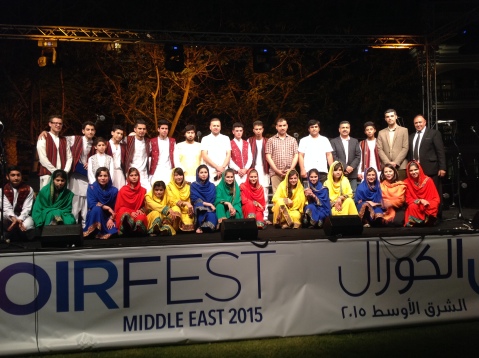 For my part, I felt privileged to be able to observe the group at work and play. Short of going to Afghanistan (which my university won’t let me do – which means that I wouldn’t be able to use any data I gathered there for my PhD dissertation), this was the best way for me to get to do this. I was also able to interview students about their experiences of being a music student in the midst of a war-affected and volatile environment, and many cultural barriers and obstacles. I chatted with them in English (with those that knew English), in Italian (some of the girls knew Italian), in Russian (one faculty member spoke Russian – mine was very rusty indeed, as I last spoke Russian about 20 years ago), and in Dari with the help of interpreters.
For my part, I felt privileged to be able to observe the group at work and play. Short of going to Afghanistan (which my university won’t let me do – which means that I wouldn’t be able to use any data I gathered there for my PhD dissertation), this was the best way for me to get to do this. I was also able to interview students about their experiences of being a music student in the midst of a war-affected and volatile environment, and many cultural barriers and obstacles. I chatted with them in English (with those that knew English), in Italian (some of the girls knew Italian), in Russian (one faculty member spoke Russian – mine was very rusty indeed, as I last spoke Russian about 20 years ago), and in Dari with the help of interpreters.
This fieldwork travel was supported by SEMPRE (the Society for Education, Music, and Psychology Research), who awarded me a Gerry Farrell Travelling Scholarship in 2014. I thank them most sincerely for making this travel possible and supporting my research in this way.
Fieldwork in Dubai
This morning I got on a plane to Dubai. I only booked the flight last night. I’m on a fieldwork trip but have no idea if the people I hope to interview and observe will actually be in Dubai or not. It’s nerve-wracking, this not-knowing, but also kind of thrilling to cross your fingers, jump on a plane, and take a punt that everything will work out fine.
My PhD research investigates people’s experiences of music learning in the aftermath of war and violent conflict. I embarked on it in 2013 and have loved every minute so far. I am focusing on music schools and other ‘organised’ or structured initiatives in conflict-affected settings, and I have three case studies – the Pavarotti Music Centre in Bosnia-Herzegovina, the Hadahur Music School in Timor-Leste, and the Afghanistan National Institute of Music [ANIM]. The first two sites have been easy enough to visit in order to interview students and other participants and observers; however, organising fieldwork in Afghanistan has been challenging. The conflict has intensified and come closer to Kabul in the time since I started my research and my university hasn’t allowed me to travel there.
So why am I going to Dubai? The ANIM Choir has been invited to participate in a 5-day choir festival, called ChoirFest Middle East. Their participation has been on the cards for a while (I first learned of it at the end of January), but the bureaucratic hurdles that must be navigated to get the necessary Afghan government clearances for student travel are considerable, even when every department responds positively and efficiently. The first hurdle was getting government approval for the travel, which then enabled the process for getting their passports released to start. The passports were released mid last week, and that triggered the process of applying for visas to enter the United Arab Emirates. The students are scheduled to fly today (Wednesday) and the school expects the passports to be ready just a few hours before their flight would depart.
I had a choice – wait and find out if they get the visas or not (and risk missing their performance and other data-gathering opportunities, as well as risking flight availability), or fly without knowing for sure that they would travel.
Sometimes you just have to go with your gut. On this occasion, I felt like I’d been waiting on tenterhooks to confirm the travel for so many days, it was a relief just to go. But also, I figure that if I go, I will find something interesting, even if the ANIM group doesn’t arrive. The event itself sounds interesting. There will be choirs from other parts of the Middle East (Iran, Lebanon, and maybe even Iraq), and the organisers have been very welcoming of an outside researcher observing the events. I will be staying in the same hotel as all the visiting choirs, so there will be good opportunities for informal conversations and socialising. And I have a good feeling about the ANIM visas, indeed, I am optimistic! This is not their first international travel, nor their first visa application. My gut feeling is that all will be fine.
PS. I wrote this post while I was on the plane. It is now Thursday morning and I am enjoying my buffet breakfast at the hotel in Dubai. I now know whether the ANIM students made it to Dubai or not – but I like the idea of a cliff-hanger, so will keep you waiting until the next post!
Things you may not know about travel to Dili
Thinking of travelling to Timor-Leste? Here are some useful things to add to your travel information:
Clothes
You can buy great second-hand clothes at the markets, so don’t stress about bringing everything you think you might need with you from home. It’s easy to find dresses, tops, pants, and even warm things at the markets. There are several major market sites. I went to Manleuana a couple of times on this recent trip; Hali Laran is also huge and very popular… a sprawling, rambling market with lots of makeshift stalls. From the road it looks like the size of a small suburb. Manleuana is a purpose-built market space. The stall holders used to have their market in the hustle and bustle of Comoro but that market was closed down and everyone moved to this new site, which is much further out of the city. We went there in part to support the stall-holders. Also because the smaller number of shoppers meant that we might find amazing clothes. My co-shoppers found some real treasures – Yves St Laurent shoes and a sequinned Max Mara evening top, very stylish. Lots of things to fit the big bodies of well-fed foreigners.
You may wonder why one needs to buy warm clothes in a tropical country. You will need them if you go to the mountains. I bought a warm puffer jacket with a fur-lined hood at Manleuana for $10 and I was extremely grateful for it when I went to Hatobuiliko (near Mount Ramelau, Timor’s highest mountain which is just 2000 metres below the snow line – pretty high and cold for a tropical island) for the weekend. I also bought a warm roll-neck top, a long-sleeved t-shirt, and a pair of leggings to wear under my jeans. I couldn’t find any socks in the market place – bring your socks from home, perhaps, or buy them new in one of the supermarkets.
Mozzie repellent
You have to pay attention to mosquitoes in Timor-Leste – they are abundant, and carry lots of horrible viruses and illnesses. In the last month, I heard of two people who had chikungunya (the virus I caught when I was there in 2010, very unpleasant), a friend of a friend who got dengue within a week of his arrival in-country, and another friend who came down with malaria. In one month.
It’s difficult to avoid getting bitten. I had always placed my trust in Tropical Strength Rid, but the roll-top bottle I bought just before leaving Australia turned out to be faulty – the roller-ball wouldn’t roll, which is a fairly critical design fault. I had to turn to a locally-available alternative, and that is how I discovered Soffell. The bottle is pretty and pink (a very different style of visual communication to the robust aggression of Tropical Strength Rid). The lotion is scented with geranium. It costs $1.50 in local pharmacies and is apparently an Indonesian brand.
Soffell really keeps the mozzies off. I was very impressed. I am one of those people that is bitten often. I will be slapping away at the mozzies and scratching my bites while others in the room won’t have been bitten at all. But with Soffell, I was bitten far less often. In my last week in Timor-Leste, I didn’t get bitten once. That certainly wasn’t the case when I was slathering myself in Tropical Strength Rid.
Pronunciation of supermarket names (for Australians)
There are several big supermarkets in Dili, and people with Australian accents should take care to pronounce the names of two of these with care, for the sake of clarity and accuracy, and to make sure your taxi driver takes you to the right place. Leader (with a D and an R) is near Comoro. Lita (with a T and an A at the end) is in Lecidere, near the beach and past the World Bank building. Standard Australian pronunciation (which, let’s face it, can be a bit sloppy on certain consonants and turns lots of vowels into vague schwas) can make these store names sound pretty much the same. If someone says the name of the shop to you, it is worth clarifying: “Do you mean LeaDER [with strong R sound], or Li-TA [with carefully enunciated T-sound, and an open A-sound at the end of the word]?” Friends taught me to do this when I first arrived in Dili in 2010, and it is still useful to keep in mind.
Otherwise, you might find yourself on completely the opposite side of town to what you were expecting.
Back to Dili, 2014
Last time I was in Timor-Leste (also known as East Timor) I spent most of my four months outside of the capital city Dili. That was in 2010. I had a total of three weeks in Dili at the beginning of my trip, during which time I attended Tetun language classes and jumped through the bureaucratic hoops associated with obtaining a visa extension (most of which involved finding the correct office, building, person, or form, and standing in queues), but otherwise I lived in rural towns.
I enjoyed the buzz of Dili for those first three weeks. There was always something going on. I stayed with friends and completed my Tetun language homework every afternoon with the help of local children. We would chat, and sing, and just hang out together on the veranda of my friends’ Dili house. However, I was only there for a short time, and I never felt like I got to know Dili all that well.
I feel like I have made up for this now, having just spent a month in Dili doing fieldwork for my PhD. I spent each day visiting music programs and interviewing individuals with interesting experiences to share with me. I caught lots of taxis, and grabbed meals wherever I was at the time I was hungry. I stayed with friends again, who drew me into their social circles, so I met lots of welcoming people, each engaged in interesting work, good for a story, and happy to offer suggestions for further contacts for my research.
At the moment in Dili there is a huge amount of building and construction work going on. Much of this must be completed within a tight timeframe, as it is part of an effort to smarten up the city in readiness for the forthcoming Community of Portuguese-speaking Countries [CPLP] Summit. Timor-Leste currently holds the rotating Presidency for the CPLP, and thus will play host to the Summit, which brings the Presidents and high-ranking officials from all the countries in the CPLP together. The Summit is scheduled for mid-July, and Dili is in the throes of major upgrades, renovations and improvements. Everywhere you go, roads are being dug up, at least along the routes that the Presidential vehicles will drive. Piles of rocks, stone and rubble are commonplace. There is huge amount of dust in the air, and many people walk the streets or ride their motorbikes wearing surgical masks.
Most striking is the shiny silver corrugated iron that has been wrapped around many sites, shielding them from view. Some say that these barriers are to give the turf that is being laid time to grow, and to “protect it from Timorese children!” (Poor little Timorese children, being scapegoated like this!). It may also be designed to hide unsightly construction sites from view.
The corrugated iron is so shiny, and so silvery! It gives the city a slightly surreal, space-age look. It reminds me of the cake decorating accoutrements we had in my family in the seventies, in particular the frilly, silvery wrap-around-the-cake thing that we used to decorate family birthday cakes. It looks like Dili is being populated by multiple oversize 1970s birthday cakes.
A more disappointing outcome of the city’s current facelift and spruce-up is that the food sellers that used to congregate on the beach every evening, selling barbecued chicken and ‘fish-on-a-stick’, have been moved on. In fact, people have been warned that, by the time of the CPLP meeting, any non-permanent structure on the Beach Road will be dismantled. It seems such a shame to lose these street stalls. The food they sold was tasty and inexpensive, the stalls were popular with Timorese families and visitors alike, and they gave this stretch of the city a lot of personality and character. It is sad that these hardworking people would be seen as eyesores, or as creating an unsanitary environment, rather than as contributing to the unique and attractive qualities of the city.
I stayed near the Beach Road (it does have an official name, but everyone, locals and visitors alike, calls it the Beach Road). This road now has a nice paved pathway that runs alongside the beach. It’s a relatively new addition, and I was impressed to see the large number of Timorese people jogging along it in the early evening. I don’t remember seeing many Timorese people jogging or doing other fitness or health-focused activities when I was here last time. I remember feeling quite self-conscious on the odd occasion I donned my sports gear and went out for a fast walk or jog. But there are many runners now. I also saw them running, with great stamina and grit, up the mountain road at the back of Dili, heading up towards Dare. Dili has the Dili Marathon each year – perhaps they are in training for that. Exercising suggests an optimism and faith in a controllable future (just as learning to play an instrument suggests a similar act of hopefulness and optimism). These are important steps in a city’s recovery from trauma.
Four years ago, there weren’t a lot of places that had internet access. Now, it seems like many more Timorese people are connected. Facebook is the most common platform. But also, I would say that mobile phones and mobile internet access is perhaps more affordable and accessible now; there are now competing providers which has presumably brought the costs down for consumers. Timorese teenagers seemed as connected to their phones and messaging as any of their counterparts in Australia.
I think the arrival of Timor Plaza has also added to this access to internet. When I was here in 2010, Timor Plaza was a construction site. Many people I spoke to felt unconvinced about Timor Plaza – a big shopping mall, Timor’s first, with a posh hotel and conference facilities, and a cinema, and a food hall. Would the average Timorese person be able to go there? Would they be able to afford to buy anything?
But it turns out that Timor Plaza is quite a buzzy place to go. There are always lots of teenagers hanging around, taking advantage of the free wireless (it never worked when I was there, but apparently it is usually reliable), sitting around on benches with their netbooks and laptops, doing what teenagers are supposed to do in shopping malls (hang around and not buy anything).
It is also air-conditioned. And non-smoking! (apparently the owner is an passionate anti-smoker). There is a pharmacy there, and a couple of supermarkets, a food hall where I ate a wonderful chicken biriyani, and which also includes a gelato stand, flagship stores for Timor Telecom and Telemor (or whoever the other carrier is, I can’t remember their name), I think I even saw an Apple store there! You can get printing and photocopying done, and shop for gadgets, and traditional Timorese souvenirs… even have a music lesson (there is a shopfront private music school, where kids learn piano), or a massage or a pedicure or manicure. It’s a shopping mall. It appears to be a better fit for Dili than I (and many others) originally thought it would be.
Something for everyone: The community in community music
Back in October I travelled to Singapore to take part in a music education conference. While I was there I made contact with a number of organisations working with music and communities, and was invited to experience the opening of a community singing festival supported by PassionArts, the arts and cultural team behind the People’s Association. The People’s Association works on behalf of all of Singapore’s residents living in public housing (which is most people).
The singing festival was a big event. It was on the banks of a river, with seating arranged on either side for participants, and performers located on barges and small boats as well as on the river banks. There was festoon lighting in the trees and on the footbridge connecting the two sides. I arrived quite early and sat on one of the benches on the footbridge. There were other early-birds nearby who greeted me and shared the songbook program with me. One older man gave me a plastic flashing light stick, and showed me how to switch it on by pulling out a small plastic tag in the handle. Cool!
The songs in the songbook represented the principal languages and cultures of Singapore – Mandarin, Tamil, Malay and English. I saw that later in the night we would be singing a massed rendition of “Top of the World”. Early in the program were some patriotic songs, praising Singapore as the land of many united peoples and cultures.
The people around me were mostly elderly Chinese, or parents with young children. Many people were crossing the bridge too. There was a space on the bench beside me, and life got interesting when three young boys bounced up, filled with excitement, and asked me if it was free and could they sit there. “Yes, of course!” I said, and they clamoured in. The oldest of the three was probably about nine years old. The other two were younger, aged maybe five and six, that sort of age. A fourth boy joined them not long after and tried to climb into the bench space as well. As you can imagine, they began to laugh and push and climb on each other. They were filled with energy and cheekiness and boisterousness, and had little concern for maintaining a low profile or subduing themselves in the presence of all these older people. They reminded me of the boys in Timor-Leste that used to come to my house everyday to play music.
They asked if they could see my light stick. I showed it to them. “How do you make the light work?” asked one. “It’s a secret, see if you can figure it out” I replied, wanting to give them permission to play with it and figure it out. Of course they found the plastic tab quickly and the light stick was duly waved in the air for a while, before being politely given back to me.
I loved observing these boys. They were clearly so excited to be there. They spoke to each other in Malay, with only the oldest being confident in English. They pushed and jostled and laughed and joked, all the while responding to the developments further down on the river bank, where things seemed to be in the final stages of preparations. However, their boisterous energy drew some frowns from my neighbours. People admonished them to sit still and be quiet. They looked over at me the top of the boys’ heads, shaking their heads and frowning slightly.
Then the younger boys decided they wanted to go somewhere else. They scampered away as quickly and nimbly as they’d arrived. The older boy lingered slightly and said, “We’ll come back. Can you mind this place for us?” “For sure,” I agreed, and put my bag on the seat.
At first I did a good job of protecting the seat. Other people nearby seemed to think it was unnecessary, but the boys had asked me to do this and I had agreed, so I wanted to be true to my word. “They should be with their parents,” one person muttered. Another shook his head and said, “Well, they haven’t paid”. (It was a free event, but paying $2 bought you a show bag with the songbook and light stick in it. I hadn’t done this either).
The boys came back after a short time, squeezing in beside me again, and I felt pleased that I had done as I promised and kept their seat for them. I fell into conversation with the oldest boy again. But within ten minutes or so, he and his friends got up to leave again, and once again, they asked me to save their seat.
During this second absence, there was a lot more demand for seats on the bench. An older woman, with a younger woman and a baby in a pram, asked if this space was available. I explained that some younger boys had been sitting there and had asked me to save the spot for them, but the other people around me began shaking their heads and saying words to the effect of, No, this space is not for them. I didn’t like to see the older woman standing, nor the younger woman and the small child. So I relinquished the space.
The singing began and people around me joined in with huge enthusiasm and an impressive and undeniable commitment. This event was not just a fun pastime, it felt like it was important to them on another level – important to sing together, important to contribute their voices to the overall sound.
The time came for me to go. The young boys hadn’t come back, so I said good-bye to my neighbours, and offered the light stick and songbook back to them. “No, no, take it with you,” they told me. But I was about to get on an aeroplane to Europe – I knew that was not a practical option.
I climbed off the bench with my big bag, and that was when I saw that the oldest of the three boys was standing behind me. He must have returned, but seen immediately that the space for him to sit in was no longer there, so just stayed standing behind. I wondered if he felt I’d let him down. I was really pleased to see him and greeted him. I gave him my light stick and told him to sit in my place. I didn’t see whether he decided to do this or not.
I loved the way that this boy in particular was so interested in the community singing festival event. It attracted him. He was drawn to the pageantry, I think, and to the fact that something like this was happening. He was wide-eyed and engaged, and excited by what was going on.
But it didn’t seem straightforward for him to be there. He wasn’t a natural fit with the rest of the audience-participants. This made me think about the reality of community events – ostensibly they are for everyone, but will usually become dominated by a particular group – whether that be an age group, a social class group, an ethnic group, and so on.
This is one of the tensions inherent in organised community events. They are about social bonding and shared experiences, but they are also about inclusion. People will be bonded as a group, but the group must at the same time always remain open to newcomers. It is a commitment that the group makes (asserted and reinforced constantly by the group leader or organiser) at the foundations of it its very existence.
The contradiction inherent in the unconditional welcome when coupled with bonding through shared experiences is a challenging quality to program for and manage. The larger the event, the less control the management team will have over this characteristic being maintained. Perhaps this was something of what I observed on the footbridge at the community singing festival.
I thought about the boy for a long time as I made my way back to my accommodation and got ready to go to the airport. He moved me enormously. I thought about how precious that spark of curiousity is in a young person, and how filled it is with promise and potential. It can also be easily extinguished, through lack of nurturing – being blocked outright, or left alone to dwindle away.
I hope that this young boy is already someone who is engaged in organised and participatory activities in his community, that his curiousity and openness has been identified and is being nurtured and encouraged. So many people – young and old – live in a way that is confined by the rules and expectations of their social group. They conform. The small number of people who, from a young age, are seekers of new experiences, curious about what else is out there, and prepared to take calculated risks in order to learn and grow, are important to nurture in our communities. They can be catalysts and leaders, or simply the people that proffer an alternative point of view, through having the courage to hold their own convictions.
Remembering and revisiting Herzegovina
When I lived in Mostar in 1998, I visited a town called Ljubinje every week. Ljubinje is about 2 hours drive from Mostar, and was in the Serb-governed territory, Republika Srpska. Ljubinje was isolated, a small town on the edge of Republika Srpska, right on the edge of the so-called Inter-Entity Border which divided the Republika Srpska from the Muslim-Croat Federation. This complex organisation of the nation-state of Bosnia & Herzegovina is thanks to the Dayton Accord peace plan that brought an end to the 1992-95 wars but enshrined division along ethnic lines across the land, and wrote these divisions into the Constitution.
To get to Ljubinje, I would drive out of Mostar (Bosniak territory) and almost immediately enter ‘Croatian’ territory. There were no visible borders or demarcation lines between the Bosnian and Croatian territories, but at that time, people of one group didn’t tend to enter the territory of another group – they would feel unsafe or uncomfortable. Car number plates clearly showed which part of the country you came from, including a symbol or shield insignia that left no doubt which ‘ethnic entity’ the car belonged to. Mostar at that time felt like a ghetto to many of the local people, with only one road out of town that did not pass through other entity territory.
Ljubinje and the other towns between it and Mostar are in Eastern Herzegovina, a land of very dramatic landscapes – all looming rocky cliffs, mountains in the distance, and the intense blue waters of the Neretva River carving a rough and jagged path through the landscape. The roads were okay; I can remember one particular point on the journey where three land mines had been placed, equidistant from each other across the middle of the road, and once detonated, had left three neat holes in the road. Driving cleanly between these holes became a weekly goal that took me some time to achieve.
We drove through the town of Stolac. Stolac remains forever etched in my memory from that time for two reasons – the Bogomil tombs and the dynamited houses that we drove past each week.
The Bogomil tombs are tombs from ancient people that dwelled in this region centuries ago. They are striking in the landscape – like standing stones in the UK and Ireland. However, these are tombs, and each stone is etched in stylised designs and symbols. We drove past them every week but never stopped (we were always running late for the Ljubinje workshops). It was only in my last week in Mostar that I made the effort to stop, get out of the car and explore the site in detail.
The dynamited houses were a result of the returns process that was underway at that time. People will remember that a characteristic of the Bosnian wars was the violent expulsion of groups of people from their homes. These people would be forced to leave (often very violently, terrorised and brutalised by the militia groups that expelled them) find shelter in another part of the country, a part that was held by their own ethnic group. By 1998, expelled people were gradually being encouraged (by the international forces, and the terms of the Dayton Accord and peace plan) to return to the homes they had left. But in Stolac, these homes would be dynamited right before the people were due to return. Every week, I would see freshly dynamited houses on the road in and out of Stolac.
During my fieldwork over the last few weeks in Bosnia-Herzegovina I had the opportunity to return to Stolac, and to reconnect with the teacher I used to work with In Ljubinje. I met him with my translator in the evening in a café in Stolac. We arrived a little early so were able to take a walk through the town, alongside the river. The sun was setting, and the colours were golden. Like many other Herzegovinian towns, Stolac is a valley town, surrounded by steep hills. The river cuts its way through the centre of the town.
I was surprised by the hilltop fortress in Stolac.
“I don’t remember it,” I said to my friends. “I’m surprised I never noticed it before.”
“It’s been restored,” they told me. “It was damaged in the war, so it probably wasn’t very noticeable last time you were here.
The walk through the town alongside the river has some nice scenery. As in most of this region, you find ruins sitting alongside reconstructed and brand new buildings, and some older buildings still pockmarked with scars from shelling.
We found a pleasant restaurant where I ate an excellent pljeskavica (local version of hamburger). I also proved delectable prey for a lone mosquito, who bit me up and down my right leg while I sat at the table. The bite marks are only just starting to fade.
It was wonderful to reconnect with Sergej, the teacher we worked with in Ljubinje back in 1998. Sergej had established a drama group for local high school students at that time, and supported them to write and perform their own shows. They created over ten different original shows for the Ljubinje community between 1998 and 2013 – a significant contribution in a town that is isolated in every way. In 1998 I remember we couldn’t even telephone to Ljubinje easily – the Republika Srpska used a different phone system to the Federation.
Sergej remembered me well. We talked about his recollections of the Pavarotti Music Centre musicians coming to Ljubinje and the different workshops that took place. I learned that at that time there were other cultural NGOs coming to Ljubinje too. In fact, other organisations offered a more sustained approach than the PMC program that I was involved in, and worked with students towards public performance outcomes. Nevertheless, the PMC program gave students skills for creating original music for their shows. We also donated some drums to the group, and Sergej described a time many years later, when the drums featured in a local ceremony (the opening of the swimming pool). One of his former students, by that time a member of the police force in town, sat down at one of the drums and “all the rhythms came back to him from years before!”
Sergej has had a lot of challenges in his life since that time. But despite these, he is still the same lively and engaged person, still thinking about the young people and their needs, and believing in their importance to the town. It must be difficult to be one of only a few open-minded, culturally-oriented people in a small town. He said the internet has made a big difference in people’s lives there, it has opened people up to the wider world.
This region has seen a lot of suffering among the people that live there. I hope that the sense I have of it being a little more open, a little more relaxed, than when I was last here in 1998, is a sign of a shared and welcome progress.
 Comments (3)
Comments (3)

